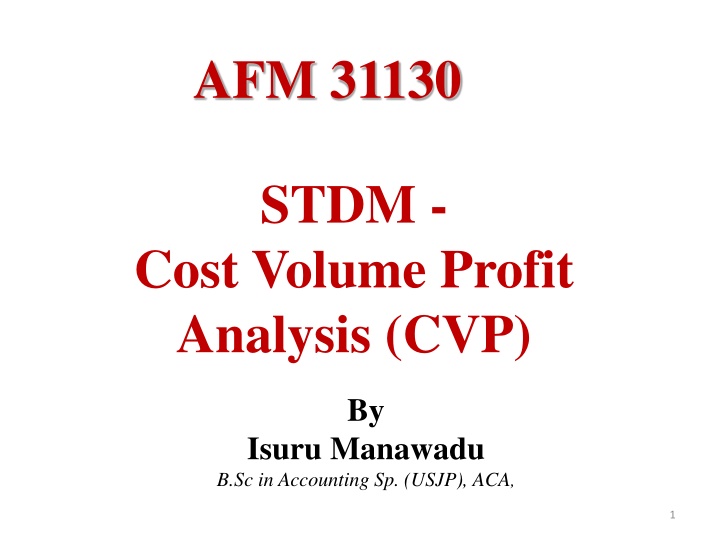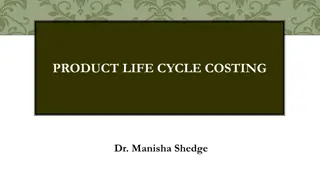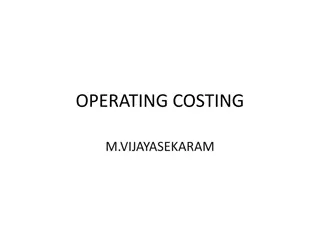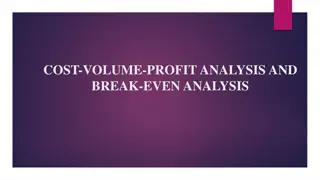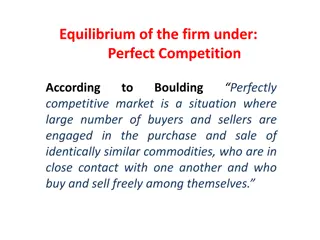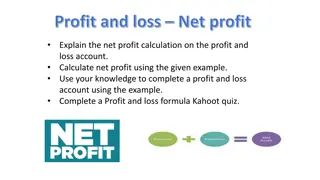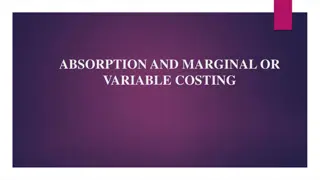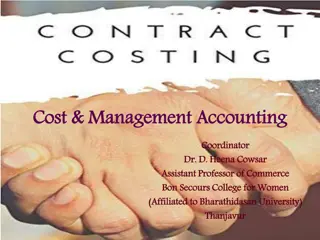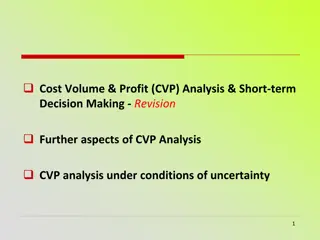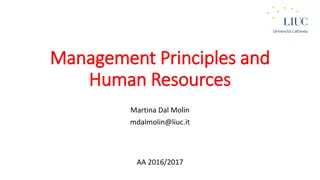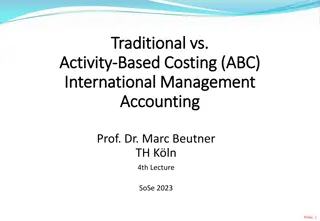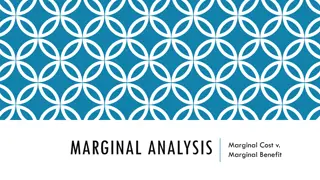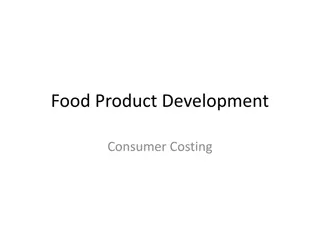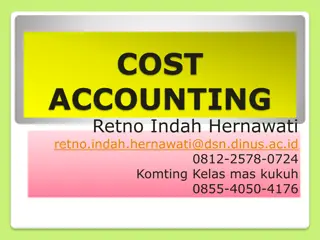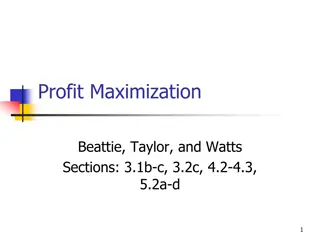Cost Volume Profit Analysis and Marginal Costing
Marginal costing involves charging only variable costs to units produced, treating fixed costs as period charges. This technique is contrasted with absorption costing, where all manufacturing costs are absorbed by units produced. Learn to determine break-even points, margin of safety, and more.
Download Presentation

Please find below an Image/Link to download the presentation.
The content on the website is provided AS IS for your information and personal use only. It may not be sold, licensed, or shared on other websites without obtaining consent from the author.If you encounter any issues during the download, it is possible that the publisher has removed the file from their server.
You are allowed to download the files provided on this website for personal or commercial use, subject to the condition that they are used lawfully. All files are the property of their respective owners.
The content on the website is provided AS IS for your information and personal use only. It may not be sold, licensed, or shared on other websites without obtaining consent from the author.
E N D
Presentation Transcript
AFM 31130 STDM - Cost Volume Profit Analysis (CVP) By Isuru Manawadu B.Sc in Accounting Sp. (USJP), ACA, 1
Learning Outcomes After studying this session you will be able to: Understanding Marginal Costing Understand Absorption Costing Distinguish between marginal costing and absorption costing Determine BEP and margin of safety Prepare different types of break even charts
Marginal Costing Marginalcosting is a costing technique where only variable or direct cost will be charged to the cost unit produced. In Marginal costing, fixed costs are never charged to production. They are treated as period charge and is written off to the comprehensive income statement (P & L) in the period incurred. 3
Marginal Costing Cont Under variable or direct costing, the fixed manufacturing overhead costs are not allocated or assigned to (not absorbed by) the products manufactured. Variable management's decision-making. costing is often useful for
Assumptions of Marginal costing or CVP Analysis. Fixed cost will remain constant Operating efficiency will not increase or decrease There will not be any change in pricing policy due to change in volume, competition etc Semi variable cost can be segregated into variable and fixed elements Product mix will remain unchanged Price of variable cost factors (Such as wage rates, price of materials) will remain unchanged
Marginal cost Cost of one additional unit of output Marginal cost per unit (The additional cost needed to produce one more unit of a good or service) = Direct Material cost per unit xx Direct Labor cost per unit xx Other Variable costs xx 6
Example: Total cost of producing 10,000 units is Rs. 50,000/= If the total production is 10,001 units the total cost is Rs. 50,005/= The Marginal cost of producing the next unit was Rs. 5/= 7
Absorption costing Absorption costing is that all manufacturing costs are absorbed by the units produced. In other words, the cost of a finished unit in inventory will include direct materials, direct labor, and both variable and fixed manufacturing overhead. As a result, absorption costing is also referred to as full costing or the full absorption method.
Absorption costing Cont Absorption costing is often contrasted with variable costing or direct costing. Absorption external financial reporting and for income tax reporting. costing is required for
Cost classifications--Absorption versus Variable costing Absorption Costing Variable Costing Direct materials Direct Labor Variable Manufacturing overhead Product cost Product cost Fixed manufacturing overhead Period cost Period cost Variable selling and administrative expenses Fixed selling and administrative expenses 10 Source www.accontingformanagement.com
Exercise A small company that produces a single product has the following cost structure. No. of units produced 6,000 Variable costs per unit: Direct materials Direct labor Variable manufacturing overheads Variable selling & Administrative expenses Rs. 2 Rs. 4 Rs. 1 Rs. 3 Fixed cost per year: Fixed manufacturing overhead Fixed selling & administrative expenses Rs. 30,000 Rs. 10,000 1. Compute the unit product cost under absorption costing method. 2. Compute the unit product cost under marginal costing method. 11
Absorption Vs. Marginal Costing - Exercise Following details relate to the 100,000 units of product X produced and sold by ABC Ltd. during the year. Rs. Sales @ Rs. 10 per unit Direct material @ Rs. 3 per unit Direct labor @ Rs. 2 per unit Variable overheads @ Rs. 1 per unit Fixed overheads for the year 1,000,000 300,000 200,000 100,000 200,000 Prepare the profit statements under marginal costing and under absorption costing. 12
Contribution Contribution is the difference between sales And the marginal (Variable) cost Contribution = Selling price Variable cost 13
Break Even Point (BEP) Break Even is the point where businesses are not making profits At this stage; TR = TC BEP (units) = Fixed cost Contribution per unit 14
Break Even Point (BEP) BEP (Sales value) = Fixed cost PV ratio
Profit Volume Ratio (PV) PV = Contribution X 100 Sales
Margin of Safety (MOS) In break-even analysis, margin of safety is the extent by which actual or projected sales exceed the break-even sales. It may be calculated simply as the difference between actual or projected sales and the break-even sales. formula to calculate margin of safety: MOS = Budgeted Sales Break- even Sales
Use the following information to calculate: Contribution BEP in units BEP in sale value Margin of safety Sales price per unit Rs. 40 Variable cost per unit Rs. 32 Total fixed cost Rs. 7,000 Budgeted sales 1000 units 18
